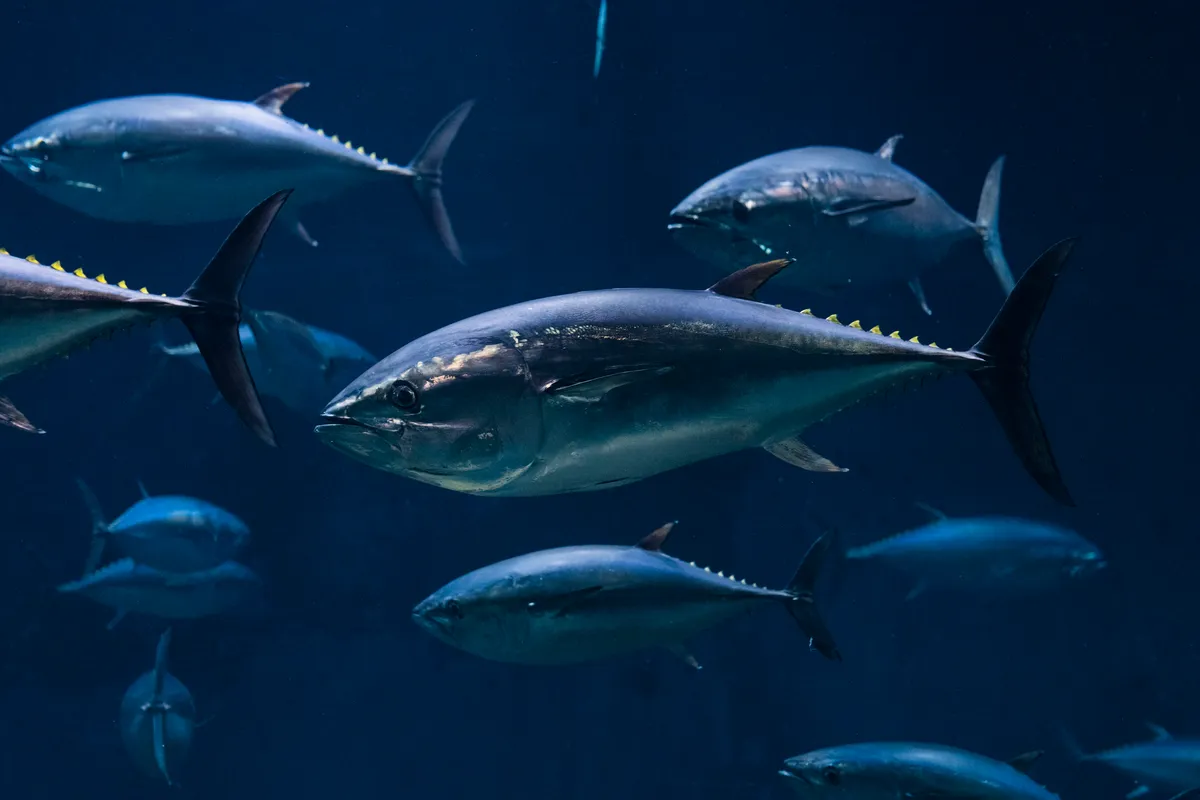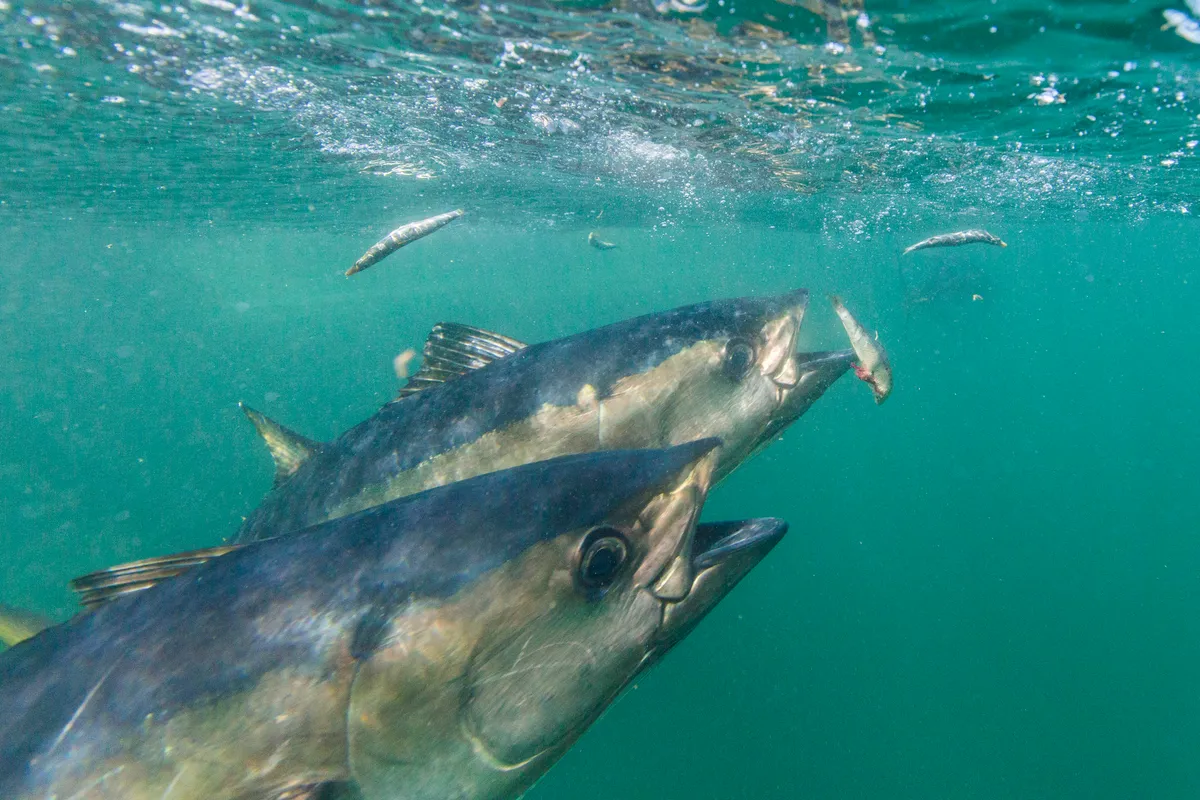Once a common species in the North Sea, bluefin tuna are quite a rare sight in UK waters due to overfishing of both the tuna and their prey. However, they are now being increasingly sighted around the British Isles, which may be because of warming waters due to climate change; making waters more hospitable for them, or potentially due to stock increase.
What is the scientific name of the bluefin tuna?
There are three species of bluefin tuna: Atlantic (Thunnus thynnus), Pacific (Thunnus orientalis), and Southern (Thunnus maccoyii). Within the Atlantic species, there are two distinct stocks: Eastern Atlantic and Mediterranean bluefin tuna, and Western Atlantic bluefin tuna.
What are bluefin tuna related to?
Bluefin tuna are a ‘true-tuna’, being part of the genus Thunnus within the Scombridae family. Their closest relatives are the other ‘true-tunas’ that include yellowfin, bigeye and albacore tuna. All ‘true-tuna’ are wide-ranging species found throughout the world’s oceans but primarily within the open ocean where they are apex predators.
There are other species of tuna that are not ‘true-tuna’ but are within the same family. These include the most commonly consumed tuna in the world, skipjack tuna, as well as smaller species such as bonito and two of the most prized angling fish, the dogtooth tuna and Spanish mackerel.
How to identify bluefin tuna
You can’t really mistake an East Atlantic bluefin tuna in UK waters with any other fish – they often leap out of the water and so can be easily identified by their unique look. The only other tuna that can make it to UK waters is the albacore tuna, but they are much smaller than bluefin and look quite different.

Elsewhere, in other oceans you could mistake yellowfin with bluefin tuna. However, bluefin are tinged blue and silver in comparison to green and yellow on a yellowfin tuna. Bluefin pectoral or (side) fins also don’t reach past the beginning of their second dorsal (top) fin. Their second dorsal fin is also a mixture of grey and yellow in colour and their tail fin is also dark blue in colour.
Where do bluefin tuna live?
Bluefin tuna spend most of their life in the open ocean and are found in most oceans around the world. There are distinct stocks in the Atlantic, Pacific and Southern oceans, that don’t mix.
The ones we see off the coast of Britain are the East Atlantic bluefin stock. They spawn in the Mediterranean Sea and migrate in the Atlantic Ocean northwards towards the UK and Norway and southwards towards West Africa in the Atlantic. So, they are regular visitors rather than residents.

The West Atlantic bluefin stock spawn in the Gulf of Mexico and migrate across the North Atlantic from Ecuador to Norway. As with salmon, Atlantic bluefin are loyal to their breeding grounds and often return to their birthplace to spawn.
Pacific bluefin tuna inhabit the northern waters of the Pacific, primarily from the coasts of Japan and China to the western coast of North America. This stock of bluefin tuna typically prefer temperate waters, spawning in the north west Philippine Sea and in the Sea of Japan. Unlike the Atlantic, Pacific tuna are all part of one single stock.

Southern bluefin tuna typically live in oceans found in the Southern Hemisphere, from the tropics to the sub-Antarctic. They make yearly spawning trips to the southeast of Java. They mainly range in the east Indian Ocean, through the Southern Ocean and into the southwest Pacific.
How many bluefin tuna are there in British waters?
When the UK was part of the EU, fishing vessels registered in the UK were prohibited to catch bluefin tuna, with no quota under UK law or international fishing agreements. Any caught incidentally when fishing recreationally or in nets, had to be returned to the sea, alive and unharmed to the greatest extent possible. They could only be brought to shore for means of scientific research.
In 2011, an Atlantic bluefin tuna weighing 160kg and 2.3 metres in length was caught by fishers and handed over to marine biologists at The University of Exeter for students to study. Since Brexit, the UK now has a very small quota for bluefin tuna, though there is no commercial fishery for it yet.
Back in the twentieth century Atlantic bluefin were a common sighting in the North Sea. In fact, fishing for adult bluefin tuna off the coast of Whitby and Scarborough was a pastime of wealthy people. But as overfishing continued for both bluefin and their prey species - such as herring and mackerel - populations began to decline, and so did the sightings of bluefin tuna.
Though still rare to see today, the Eastern Atlantic bluefin stock are increasingly sighted around the British Isles. Scientists think this might be because of warming waters due to climate change; making waters more hospitable for them, or potentially due to stock increase.
A tracking project called the ThunnusUK tagging program has been set up to help scientists decipher their movements to and from UK waters, and, a project off the Western Isles of Scotland is working with local fishers to help tag tuna back on their way to the Mediterranean.
How big can bluefin tuna get?
Bluefin tuna start out no bigger than an eyelash, gaining 1 kg in the first 6 months; at 10 years, a bluefin tuna is around 2m / 170 kg and can reach 2.7 m / 400 kg at age 20.
The world record for the biggest bluefin caught has stood since 1979 when a 679 kg bluefin was caught off the coast of Nova Scotia, Canada.
What do bluefin tuna eat?
Bluefin tuna are ocean predators employing an opportunistic feeding strategy. Young tend to feed on crustaceans, fish and cephalopods (such as squids) but adults feed on fish such as herring, anchovies, sardines and horse mackerel, depending on which bluefin stock you look at.

What eats bluefin tuna?
Being the largest tuna species in the oceans, bluefin tuna is caught by fishers around the world for human consumption.

However, there are currently only two bluefin tuna fisheries which are Marine Stewardship Council (MSC) certified – the Usufuku Honten Northeast Atlantic longline bluefin tuna fishery and the SATHOAN French Mediterranean Bluefin tuna artisanal longline and handline fishery.
Usufuku’s catch of Eastern Atlantic bluefin tuna is sold exclusively in Japan for the domestic sashimi/sushi market.
Likewise, the Mediterranean bluefin tuna fishery’s catch is mainly destined for consumers in France, so sustainable bluefin tuna is not available for consumers in the UK.
Are bluefin tuna endangered? What threats do they face?
Southern bluefin tuna are classed as Endangered by the IUCN Red List and Pacific bluefin tuna are classed as Near Threatened. Atlantic bluefin tuna was considered Endangered in 1996 and by 2006 it was at risk of Extinction. However in 2021, Atlantic bluefin tuna was recategorised from Endangered to Least Concern by the IUCN Red List, attributing its recovery to countries enforcing sustainable fishing quotas and successfully combatting illegal fishing.
The update showed that Eastern Atlantic bluefin stock which spawns in the Mediterranean has increased by at least 22% over the last four decades, while the Western Atlantic stock which spawns in the Gulf of Mexico, has declined by more than half in the same period.
Please note that external videos may contain ads:
Tracking Bluefin Tuna | A Perfect Planet © BBC Earth
What work is being done to help bluefin tuna?
As overfishing currently threatens all bluefin tuna populations, as well as unreported and unregulated fishing of Southern bluefin tuna, fisheries that rely on bluefin tuna for their livelihoods must move towards becoming sustainable to secure their future.
Fisheries that wish to demonstrate and continuously improve their sustainability can apply for Marine Stewardship Council (MSC) certification. The MSC program advocates for sustainable fishing globally and uses a market-based mechanism which incentivises and rewards fisheries for moving towards more sustainable fishing practices. You may have noticed the little ‘blue fish tick’ ecolabel when purchasing seafood. This ecolabel helps consumers have confidence that the seafood they’re purchasing comes from a sustainable source.
Consumers are also helping to support important sustainability research in fisheries when choosing MSC certified as sustainable labelled seafood. At least 5% of MSC’s annual royalties from certified as sustainable labelled seafood are redirected to the MSC Ocean Stewardship Fund. Since launching in 2019, the fund has so far awarded over £2.1 million through a total of 64 grants to accelerate sustainable fishing globally. This year, the Mediterranean bluefin tuna fishery was awarded a grant to conduct a tagging project on stingrays that can become accidentally caught on longline hooks. Though stingrays are released, the fishery wants to collect better data to understand how the population could be impacted long-term. The project is linked to a condition – or improvement – the fishery must make to retain its MSC certificate.
One of the main difficulties in managing bluefin tuna is that they are highly migratory and their populations span across vast areas of the oceans. This includes areas in the High Seas as well Exclusive Economic Zones (EEZs) managed by specific nations or groups of nations, so good management of commercial fishing requires international cooperation between governments and fisheries.
The International Commission for the Conservation of Atlantic Tunas (ICCAT) is the Regional Fisheries Management Organisation (RFMO) responsible for conserving stocks of bluefin and other tuna in the Atlantic. ICCAT is now committed to the development of a full Management Strategy Evaluation. This is the best tool we have for managing a species from a scientific point of view. It includes the development of management and operational objectives and the establishment of harvest control rules as part of improving its harvest strategy. Harvest control rules are a series of pre-agreed rules which help the RFMO and fisheries respond to changes in stock levels so that overfishing doesn’t occur. A harvest strategy combines stock monitoring, assessment, harvest control rules and management actions as well as other processes.
A fully functioning harvest strategy enables RFMOs to ensure certain social, ecological and economical goals are being met, alongside relevant stakeholders. These actions will continue to help scientists, NGOs, governments and fisheries manage this stock of bluefin tuna sustainably into the future. ICCAT is currently in the final stages of development of a fully functional Harvest Strategy. The objective is that this harvest strategy is adopted at this year’s commission meeting in November.
For more information on tuna species, you can see the MSC’s Tuna Handbook guide.
Main image: Bluefin tuna feeding in Australia. © Getty
